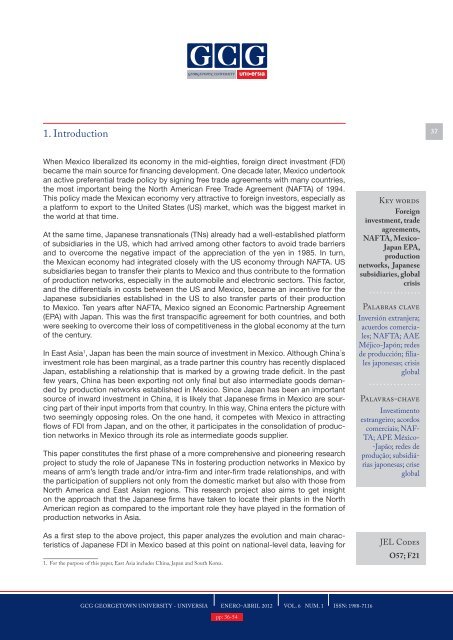Vol. 6 Num. 1 - GCG: Revista de Globalización, Competitividad y ...
Vol. 6 Num. 1 - GCG: Revista de Globalización, Competitividad y ...
Vol. 6 Num. 1 - GCG: Revista de Globalización, Competitividad y ...
Create successful ePaper yourself
Turn your PDF publications into a flip-book with our unique Google optimized e-Paper software.
1. Introduction37When Mexico liberalized its economy in the mid-eighties, foreign direct investment (FDI)became the main source for financing <strong>de</strong>velopment. One <strong>de</strong>ca<strong>de</strong> later, Mexico un<strong>de</strong>rtookan active preferential tra<strong>de</strong> policy by signing free tra<strong>de</strong> agreements with many countries,the most important being the North American Free Tra<strong>de</strong> Agreement (NAFTA) of 1994.This policy ma<strong>de</strong> the Mexican economy very attractive to foreign investors, especially asa platform to export to the United States (US) market, which was the biggest market inthe world at that time.At the same time, Japanese transnationals (TNs) already had a well-established platformof subsidiaries in the US, which had arrived among other factors to avoid tra<strong>de</strong> barriersand to overcome the negative impact of the appreciation of the yen in 1985. In turn,the Mexican economy had integrated closely with the US economy through NAFTA. USsubsidiaries began to transfer their plants to Mexico and thus contribute to the formationof production networks, especially in the automobile and electronic sectors. This factor,and the differentials in costs between the US and Mexico, became an incentive for theJapanese subsidiaries established in the US to also transfer parts of their productionto Mexico. Ten years after NAFTA, Mexico signed an Economic Partnership Agreement(EPA) with Japan. This was the first transpacific agreement for both countries, and bothwere seeking to overcome their loss of competitiveness in the global economy at the turnof the century.In East Asia 1 , Japan has been the main source of investment in Mexico. Although China´sinvestment role has been marginal, as a tra<strong>de</strong> partner this country has recently displacedJapan, establishing a relationship that is marked by a growing tra<strong>de</strong> <strong>de</strong>ficit. In the pastfew years, China has been exporting not only final but also intermediate goods <strong>de</strong>man<strong>de</strong>dby production networks established in Mexico. Since Japan has been an importantsource of inward investment in China, it is likely that Japanese firms in Mexico are sourcingpart of their input imports from that country. In this way, China enters the picture withtwo seemingly opposing roles. On the one hand, it competes with Mexico in attractingflows of FDI from Japan, and on the other, it participates in the consolidation of productionnetworks in Mexico through its role as intermediate goods supplier.This paper constitutes the first phase of a more comprehensive and pioneering researchproject to study the role of Japanese TNs in fostering production networks in Mexico bymeans of arm’s length tra<strong>de</strong> and/or intra-firm and inter-firm tra<strong>de</strong> relationships, and withthe participation of suppliers not only from the domestic market but also with those fromNorth America and East Asian regions. This research project also aims to get insighton the approach that the Japanese firms have taken to locate their plants in the NorthAmerican region as compared to the important role they have played in the formation ofproduction networks in Asia.As a first step to the above project, this paper analyzes the evolution and main characteristicsof Japanese FDI in Mexico based at this point on national-level data, leaving for1. For the purpose of this paper, East Asia inclu<strong>de</strong>s China, Japan and South Korea.Key wordsForeigninvestment, tra<strong>de</strong>agreements,NAFTA, Mexico-Japan EPA,productionnetworks, Japanesesubsidiaries, globalcrisisPalabras claveInversión extranjera;acuerdos comerciales;NAFTA; AAEMéjico-Japón; re<strong>de</strong>s<strong>de</strong> producción; filialesjaponesas; crisisglobalPalavras-chaveInvestimentoestrangeiro; acordoscomerciais; NAF-TA; APE México--Japão; re<strong>de</strong>s <strong>de</strong>produção; subsidiáriasjaponesas; criseglobalJEL Co<strong>de</strong>sO57; F21<strong>GCG</strong> GEORGETOWN UNIVERSITY - UNIVERSIA ENERO-ABRIL 2012 VOL. 6 NUM. 1 ISSN: 1988-7116pp: 36-54















